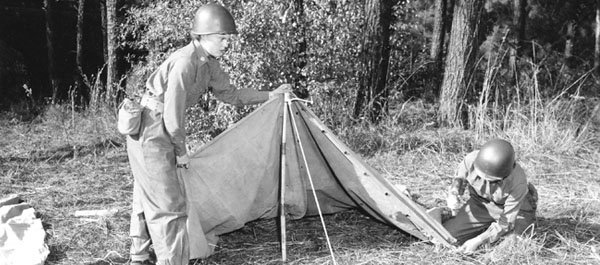The noun tycoon had a quite different meaning during the war. It signified a top leader, and was applied to Abraham Lincoln and Robert E. Lee, among others.
From the Winter 2011 Issue of MHQ
Among the linguistic legacies of the American Civil War are several expressions that have survived for a surprising number of years. One of the best known is the military command about-face, to turn 180 degrees at attention. It was—and still is in the military—performed in a specific way. The ball of the right foot is placed behind the heel of the left foot, which must then pivot 180 degrees to the right (clockwise). Originally it was “right about-face” but later often shortened. At some point the military command came to mean simply turning around, and later, in the form of to do an about-face, it had the figurative sense of reversing a decision or opinion.
The pup tent today used by campers and Scouts also owes its name to Civil War times. During the war it was also called “dog tent,” in turn slang for “shelter tent,” characterizing a small wedge-shaped field tent said to resemble a doghouse. It usually housed two soldiers, each of whom carried half the tent. The halves were buttoned together and the tent was pitched over a ridgepole or horizontal rope strung between upright poles or muskets. Today’s camp tents are far more sophisticated, and the term’s use is fading.
The noun tycoon had a quite different meaning during the war. It signified a top leader, and was applied to Abraham Lincoln and Robert E. Lee, among others. It is an adaptation of the Japanese taikun, for “great ruler” or “military leader,” applied to the shogun of Japan. Decades after the war the term was applied to business magnates, especially wealthy ones such as oil mogul John D. Rockefeller.
To do something in exact sequence is to do it by the numbers. This term described how the Union Army taught recruits to load and fire. Nine specific operations were involved in loading a Springfield muzzleloader. In Bruce Catton’s Mr. Lincoln’s Army (1951) he wrote, “Drill on the target range began with the command, ‘Load in nine times: load!’” During World War II “by the numbers” referred to such operations as putting on a gas mask, also done in numerical order. In civilian usage it can refer to any sequence, such as that of a surgeon preparing to operate (wash hands, put on gloves, put on head covering, put on face mask, etc.).
The seemingly modern expression red tape, referring to bureaucratic routine that frequently delays results, was widely popularized during the Civil War. In Abner J. Small’s book The Road to Richmond (1939), he tells of the hurdles he met when trying to get a soldier’s remains back to Maine from Virginia. He maintained that red tape was the most difficult aspect of the enterprise, harder even than obtaining the body and the money to ship it. And in Mr. Lincoln’s Army, Catton noted a young officer in the 57th New York Regiment who complained about an old officer who “suffered from red-tapeism slowness.”
Another current term that had exactly the same meaning in the Civil War as today is a drag, meaning a tedious experience, a bore. Army slang during the war, it probably alluded to the notion of dragging something that impedes progress.
A coup de grâce is a finishing stroke, or a deathblow (literally, a blow of mercy) given to end a wounded person’s suffering. The term most probably originated in dueling or other sword fighting and was adopted from French into English by 1700, but it does have a Civil War association. Ambrose Bierce, famous for his chronicles about the American Civil War, used it as the title of one of his short stories. In it a Union officer, Captain Madwell, came upon his close friend, Sergeant Halcrow, who was mortally wounded. There clearly was no chance of his surviving, so Madwell stabbed Halcrow to put him out of his misery. Later the term was transferred to more benign uses, such as the finishing touch on any project or undertaking, as in “The angel on top of the church tower was the architect’s coup de grâce—critics hated it.”
The woman who owned or managed a house of ill repute had been called a madam since the late 17th century, but it was the Civil War, which introduced thousands of farm boys to commercial sex, that made the word familiar to most Americans. It survives today.
Christine Ammer has edited encyclopedias and written several dozen wordbooks, including Have a Nice Day—No Problem! A Dictionary of Clichés (1992).






